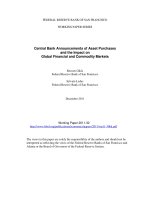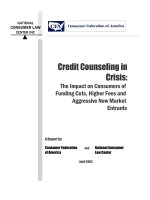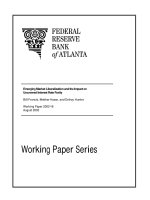Financial accounting the impact on decision makers 9e chapter 8
Bạn đang xem bản rút gọn của tài liệu. Xem và tải ngay bản đầy đủ của tài liệu tại đây (3.41 MB, 56 trang )
Chapter 8
Operating Assets: Property, Plant,
and Equipment, and Intangibles
Operating Assets
Two categories of operating assets presented on the
balance sheet:
Property, Plant and Equipment
Intangible Assets
Presented at their acquisition cost (historical cost)
Essential to a company’s long-term future
Used to produce the goods or services the company sells to
customers
Constitute the major productive assets of many
companies
LO 1
Balance Sheet Presentation of
Property, Plant, and Equipment
Balance
sheet uses one line item for property,
plant, and equipment and presents the details
in the notes
Acquisition of Property, Plant, and
Equipment
Initially
recorded at acquisition cost or original
cost
Includes all cost normally necessary to acquire
an asset and prepare it for its intended use
Purchase
price
Taxes paid at time of purchase (for example, sales
tax)
Transportation charges
Installation costs
LO 2
Group Purchase
Firm
purchases several assets as a group and
pays a lump-sum amount
Acquisition cost of each asset is separately
measured on the basis of the proportion of the
fair market value of each
LO 3
Example 8.1—Determining Cost When
a Group of Assets Is Purchased
Assume that on January 1, ExerCo purchased a building and the
land on which it is situated for $100,000. The accountant
established the assets’ fair market value on January 1 as follows:
Based on the estimated market values, purchase price should be
allocated as follows:
To land
$100,000 × $30,000/$120,000 = $25,000
To building
$100,000 × $90,000/$120,000 = $75,000
Example 8.1—Determining Cost When a
Group of Assets Is Purchased (continued)
The effect of the transaction can be identified and
analyzed as follows:
Capitalization of Interest
The
interest on borrowed money should be
treated as an expense of the period
If a company constructs an asset over a period
of time and borrows money to finance the
construction
The
interest incurred during the construction period
is not treated as interest expense
The interest must be included as part of the
acquisition cost of the asset
LO 4
Land Improvements
The
acquisition cost of land should be kept in a
separate account because land has an unlimited
life and is not subject to depreciation
Costs associated with land should be recorded
in an account such as Land Improvements
Example:
Costs of paving a parking lot and
landscaping costs
• Have a limited life
• Should be depreciated over their useful lives
Use and Depreciation of Property,
Plant, and Equipment
Depreciation:
allocation of the original cost of
an asset to the periods benefited by its use
An asset’s decline in usefulness is related to:
Physical
deterioration from usage or from the
passage of time
Obsolescence factors such as changes in technology
The company’s repair and maintenance policies
LO 5
Use and Depreciation of Property,
Plant, and Equipment
Methods
of depreciation:
Straight-line
Units-of-production
Accelerated depreciation
The
method chosen should be one that best
matches the expense to the revenue generated
by the asset
Straight-Line Method
Allocates
the cost of the asset evenly over time
Example 8.2—Computing Depreciation
Using the Straight-Line Method
Assume that on January 1, 2014, ExerCo, a manufacturer of
exercise equipment, purchased a machine for $20,000. The
machine’s estimated life would be five years, and its residual
value at the end of 2018 would be $2,000. The annual
depreciation should be calculated as follows:
The book value at the end of 2014
Example 8.2—Computing Depreciation
Using the Straight-Line Method (continued)
The book value at the end of 2014
Units-of-Production Method
Depreciation
is determined as a function of the
number of units the asset produces
Example 8.3—Computing Depreciation
Using the Units-of-Production
ExerCo has estimated that the total number of units that will be
produced during the asset’s five-year life is 18,000. During 2014,
ExerCo produced 4,000 units. The depreciation per unit for
ExerCo’s machine can be calculated as follows:
The book value at the end of 2014
Accelerated Depreciation Method
Higher
amount of depreciation is recorded in
the early years than in later years
Double-declining-balance method: recorded at
twice the straight-line rate, but the balance is
reduced each period
Example 8.4—Computing Depreciation
Using the Double-Declining-Balance Method
Assume that ExerCo wants to depreciate its asset using the doubledeclining-balance method. The first step is to calculate the straightline rate as a percentage. The straight-line rate for the ExerCo asset
with a five-year life is as follows:
The second step is to double the straight-line rate, as follows:
The amount of depreciation for 2014
The amount of depreciation for 2015
Example 8.4—Computing Depreciation
Using the Units-of-Production (continued)
The complete depreciation schedule for ExerCo for all five years of
the machine’s life would be as follows:
Exhibit 8.1—Comparison of Depreciation and Book Values
of Straight-Line and Double-Declining-Balance Methods
Exhibit 8.2—Management’s Choice of
Depreciation Method
Changes in Depreciation Estimate
Change
in the life of the asset or in its residual
value
Recorded prospectively
The
depreciation recorded in prior years is not
corrected or restated
The new estimate should affect the current and
future years
LO 6
Example 8.5—Calculating a Change in
Depreciation Estimate
$20,000 machine originally expected to be depreciated
over 5 years. After 2 years, useful life is increased to 7
years
$3,600
$3,600
2012
2013
Depreciation
2014
revise
estimate
From 5 years to 7 years
2015
2016
Example 8.5—Calculating a Change in
Depreciation Estimate (continued)
$3,600
$3,600
$2,160
$2,160
$2,160
$2,160
$2,160
2012
2013
2014
2015
2016
2017
2018
revise
estimate
Depreciation
Example 8.5—Calculating a Change in
Depreciation Estimate (continued)
In
Example 8-5, the effect of the transaction can
be identified and analyzed as follows:









